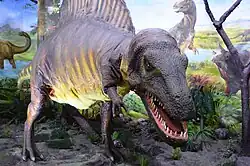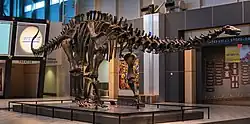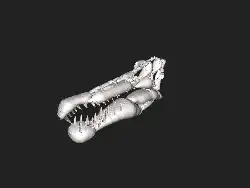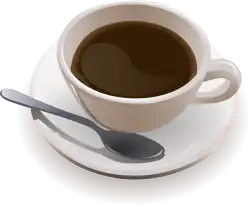3D Modelling/Animal Models
Introduction

This page about 3D Modelling/Animal Models can be displayed as Wiki2Reveal slides. Single sections are regarded as slides and modifications on the slides will immediately affect the content of the slides. The following aspects of 3D Modelling/Animal Models are considered in detail:
- (1) Create a 3D Model in Open Source software (e.g. in this learning resource Blender is used)
- (2) Decomposition of an animal model into submodels (e.g. body, claws, eye, ..)
- (3) Rigging, Armature, Animation - the animal will move
- (4) Arranging multiple 3D models in 3D scene (animal, trees,...)
- (5) Physics - let the water flow, the wind blow,...
Objective



This learning resource about 3D modelling with Animal Models. Learner will be expose with 3D design of the animal from rough geometrical shapes towards fine tuning of the geometrical model with higher details.
Imagination and scientific Correctness
Fossils of a dinosaur are the only remains found of these animals, where animation and movements of these animals are derived scientifically from the physical consideration aspect of muscles, remains of footprints in mud that can mapped to a specific animal and analogy to currently existing animals like movements of the Ostrich, which is bird which are a species related to extinct dinosaurs. Fossils are used to define the rough body shape of the 3D model. For this learning resources you might want to add references to scientific articles that provide evidence for specific animation or design patterns. Also new scientific results might change the 3D models, e.g. that some of the dinosaurs had feathers[1] that could be evolved from scales[2].
Objective - Art and Sculpting
The learners will be exposed to digital sculpting with similarities to sculpting with wood or stone. Finally the animal moves in a 3D scenery.
Target Group
The target groups for 3D Modelling/Animal Models of the learning resource are:
- students in Mathematics that want to learn about applications of geometrical operations in the context of 3D modelling
- computer science students in the context of Game Design, Virtual Reality and Augmented Reality
Learning Tasks / Activities
Learning activities focus on
- Modelling operation in Blender,
- Application scenarios for the 3D models
Install Modelling Software

The first step is to install the modelling software Blender. Open Source software is used because the learning resource is following the Open Community Approach applied to learning environments.
Recommendation for Newcomers to 3D modelling
Start with a Video tutorial for Cup (e.g. "How to make a Coffee cup in Blender Tutorial (Beginner friendly)[3] or any other Blender tutorial of your choice
Create a Dinosaur
We can use a 3D model that does not exist in real life anymore (e.g. a dinosaur). This type of animal is used in this tutorial because it can be used in learning environments to visualized with 3D models and dinosaurs cannot be viewed in a zoo or in real environments to observe their behavior and movements. Animation are used to get exposed to animal movements, that can be derived from scientific evidence and analogies to existing animals (e.g. like birds, crocodiles, ...). At the same time learner get exposed to 3D modelling techniques that used in movies or in Games.
Learning Tasks - Animals as part of 3D Scenes
Explore Blender Movies[4] to understand the render capabilities that will be address just for a single animal in the scene as one component for creating learning environments with 3D models. The Sintel Blender Movie shows the embedded usage of 3D animal models (here dragon).
Decomposition
The body of the animal is usually deformed during movement (for animation of 3D models) due to muscles and physical underlying bone movements. On the other side some elements are not deformed (like claws at the foot or the eye). Eyes and claws are typical examples for separating the 3D model into decomposed part of animal models. For the dinosaur the eyes and claws are handled and created separately as Blender models. The models are imported in the intended dinosaur model and placed at at the head and cloned multiple times at the dinosaur feet and arms.
Symmetry of the Animal
Due to the fact that animals are symmetrical (left and right side) of the animal it is a useful strategy to use a Mirror Modifier to create just one half of the animal and operation on one half of the model will add the same geometrical on the other half of the generated animal. So as a foundation of the animal learning resource, you should get into the use of the Mirror Modifier[5]
Background Reference Image
For the modelling process it is recommended as a reference image[6] to the height, width or in general the shape for the modelling scaled towards reference image. The initial approach to get the rough shape of a dinosaur can be guided by a reference image[7].
From Cube to Animal
As a starting point of the animal modelling you start with a cube with a mirror modifier[5] applied on the cube with clipping, so that both side of the symmetry are linked at the mirror plane. The basic approach to get the rough dinosaur model is to start with cube, mark a face and Extrude [E], Move/Go [G], Scale [S] of the model in the Edit Mode in Blender[7] , [S]caling, [E]xtruding and [G]Moving are performed according to the imported reference image.
References
- ↑ Godefroit, P., Sinitsa, S. M., Dhouailly, D., Bolotsky, Y. L., Sizov, A. V., McNamara, M. E., ... & Spagna, P. (2014). A Jurassic ornithischian dinosaur from Siberia with both feathers and scales. Science, 345(6195), 451-455.
- ↑ Chuong, C. M., Chodankar, R., Widelitz, R. B., & Jiang, T. X. (2000). Evo-Devo of feathers and scales: Building complex epithelial appendages: Commentary. Current opinion in genetics & development, 10(4), 449-456.
- ↑ Visual Pixels CG (2024) How to make a Coffee cup in Blender Tutorial (Beginner friendly) - Youtube Tutorial - URL: https://www.youtube.com/watch?v=anG15t4od80 (accessed 2025/04/03)
- ↑ Blender Movies Summary (2006-2023) Blender OpenSource Movies - URL: https://studio.blender.org/films/ (accessed 2025/04/03)
- 1 2 User in2vert (2023) Blender Basics - Mirroring & the Mirror Modifier Tutorial - Youtube - URL: https://www.youtube.com/watch?v=-AxJTwHXul4 (accessed 2025/04/03)
- ↑ Ryan King Art (2023) How to Use Background Images in Blender (Tutorial) Youtube - URL: https://www.youtube.com/watch?v=lpIonmH90-k (acccessed 2025/04/03)
- 1 2 Art With McKenzie (2024) Modeling a T Rex in Blender Part 1 Tutorial - Youtube - URL: https://www.youtube.com/watch?v=Lgj7ZUgNn2o&t=379s (accessed 2025/04/03)
See also
- Blender (Open Source Modelling Software)
- Open Community Approach
- Wiki2Reveal
Page Information
You can display this page as Wiki2Reveal slides
Wiki2Reveal
The Wiki2Reveal slides were created for the 3D Modelling' and the Link for the Wiki2Reveal Slides was created with the link generator.
- This page is designed as a PanDocElectron-SLIDE document type.
- Source: Wikiversity https://en.wikiversity.org/wiki/3D%20Modelling/Animal%20Models
- see Wiki2Reveal for the functionality of Wiki2Reveal.